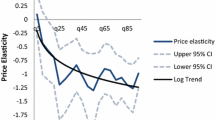Abstract
The purpose of this paper is to test Becker and Murphy's (1988) rational addiction model on 35 years of time series data on alcohol consumption in each of the four Nordic countries: Denmark, Finland, Norway, and Sweden. The empirical relevance of rational addiction theory is assessed by examining the influence of past and future consumption and contemporaneous prices on current consumption. More precisely, the rational addiction model maintains that past and future consumption should have a positive effect and that current price should have the conventional negative effect on consumption. In addition, some parameter restrictions (regarding past and future prices and consumption) implied by rational addiction are tested. Finally, the own-price elasticities from rational addiction specifications are compared to those obtained from more conventional demand specifications which ignore addiction. Ignoring addiction may provide misleading estimates of the price sensitivity of alcohol consumption and this may, in turn, lead to underestimation of the effects of major changes in price policy such as those currently taking place in the Nordic countries.
Similar content being viewed by others
REFERENCES
Assarsson, B. (1991). Alcohol pricing policy and the demand for alcohol in Sweden 1978–1988. Uppsala: Uppsala University, Department of Economics. Working Paper 1991: 19.
Becker, G. S., Grossman, M., & Murphy, K. M. (1991). Rational addiction and the effect of price on consumption. American Economic Review, 81, 237-241.
Becker, G. S., Grossman, M., & Murphy, K. M. (1994). An empirical analysis of cigarette addiction. American Economic Review, 84, 396-418.
Becker, G. S., & Murphy, K. M. (1988). A theory of rational addiction. Journal of Political Economy, 96, 675-701.
Bentzen, J., Smith, V., & Nannerup, N. (1996). A comparative study of the demand for alcoholic beverages in Denmark, Norway and Sweden. Aarhus: The Aarhus School of Business, Department of Economics. Mimeo.
Bentzen, J., Smith, V., & Nannerup, N. (1997). Alcohol consumption and drunken driving in the Scandinavian countries. Aarhus: The Aarhus School of Business, Department of Economics. Working Paper 97-1.
Berggren, F., & Lindgren, B. (1995). Alkohol — är det något för ekonomer (Alcohol — Is that a subject for economists)? Socialvetenskaplig tidskrift, 4, 298-315.
Chaloupka, F. (1991). Rational addictive behavior and cigarette smoking. Journal of Political Economy, 99, 722-742.
Greene, W. (1993). Econometric analysis. New York: Macmillan.
Grossman, M., Chaloupka, F., & Brown, C. (1998). The demand for cocaine by young adults: A rational addiction approach. Journal of Health Economics, 17, 427-474.
Grossman, M., Chaloupka, F., & Sirtalan, I. (1998). An empirical analysis of alcohol addiction: Results from the Monitoring the Future Panels. Economic Inquiry, 36, 39-48.
Hein, R. (1997). Nordic alcohol statistics 1991–95. Helsinki: National Research and Development Centre for Welfare and Health.
Keeler, T. E., Hu, T.-W., Barnett, P. G., & Manning, W. G. (1993). Taxation, regulation, and addiction: A demand function for cigarettes based on time-series evidence. Journal of Health Economics, 12, 1-18.
Mobilia, P. (1990). An economic analysis of addictive behaviour: The case of gambling. New York: City University of New York Graduate School. PhD dissertation.
Olekalns, N., & Bardsley, P. (1996). Rational addiction to caffeine: An analysis of coffee consumption. Journal of Political Economy, 104, 1100-1104.
Selvanathan, E. (1991). Cross-country alcohol consumption comparison: An application of the Rotterdam demand system. Applied Economics, 23, 1613-1622.
Suoniemi, I. (1990). Alkoholijuomien kysynnän analyysi kotitalousaineistosta (An analysis of alcohol demand using household budget data). Helsinki: Alko. Alkon taloudellisen tutkimus-ja suunnitteluyksikön julkaisuja, No. 17-20.
van Ours, J. (1995). The price elasticity of hard drugs: The case of opium in the Dutch East Indies, 1923–1938. Journal of Political Economy, 103, 261-279.
Waters, T. M., & Sloan, F. A. (1995). Why do people drink? Applied Economics, 27, 727-736.
Author information
Authors and Affiliations
Rights and permissions
About this article
Cite this article
Bentzen, J., Eriksson, T. & Smith, V. Rational Addiction and Alcohol Consumption: Evidence from the Nordic countries. Journal of Consumer Policy 22, 257–279 (1999). https://doi.org/10.1023/A:1006249715233
Issue Date:
DOI: https://doi.org/10.1023/A:1006249715233




